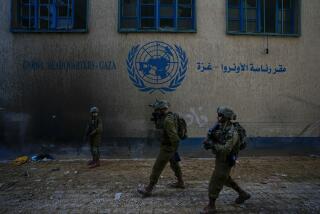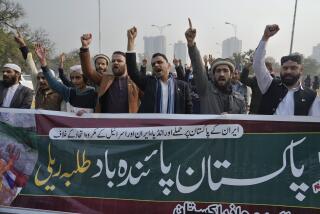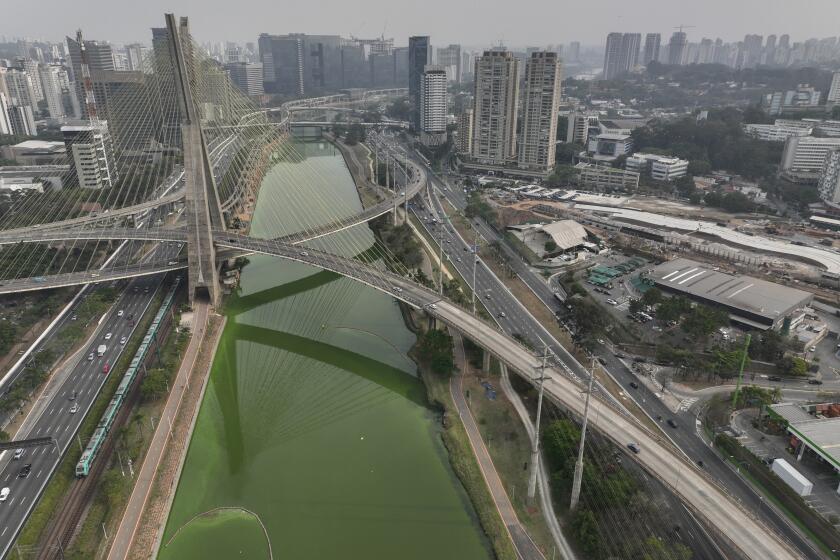Gunmen kill 6, take hostages at Pakistan’s army headquarters
RAWALPINDI, PAKISTAN — A brazen siege on Pakistan’s military nerve center by gunmen in army uniforms ended early today when Pakistani commandos rescued 30 hostages held for 18 hours.
Three hostages and two commandos were killed in the raid on a building in the army headquarters compound in Rawalpindi, said army spokesman Maj. Gen. Athar Abbas.
Four militants were killed, including one who was shot before he could detonate a vest packed with explosives in a room full of hostages, Abbas said. Most of the captives were security officers.
A fifth militant, identified as a leader of the group, was captured.
The commando raid was preceded by a furious firefight Saturday that left four attackers and six military personnel dead, including a brigadier general and a lieutenant colonel responsible for security at the compound.
By late Saturday, five gunmen had holed up with the hostages in a security building.
The initial attack late Saturday morning, which lasted about 90 minutes, illustrated the militants’ ability to launch assaults anywhere in the violence-racked nation, even in the epicenter of its vaunted security establishment.
It was the third major attack in less than a week, each aimed at a very different target: a United Nations building in the capital, a crowded market in a large northwestern city, and the home base of this nuclear-armed nation’s military.
About 11:30 a.m., Abbas said, the gunmen drove up in a white Suzuki van to a perimeter checkpoint outside the army’s headquarters in Rawalpindi, a garrison city adjacent to Pakistan’s capital, Islamabad. Armed with automatic rifles, the men opened fire at guards, jumped out of the van and took positions outside a second checkpoint about 330 yards down the road. Four of the military personnel killed in the siege died in that initial exchange of gunfire, Abbas said.
Officials said they believed that the use of uniforms, along with military plates on the van, helped the gunmen approach the first checkpoint without an initial reaction by guards.
The strategy was similar to that in an attack Monday at the U.N.’s World Food Program office in which five World Food Program employees were slain. The suicide bomber wore a Pakistani paramilitary police uniform and got through the heavily guarded main entrance by asking permission to use the restroom.
The militants Saturday, once at the second checkpoint, opened fire again and lobbed grenades. Witnesses said bursts of gunfire continued for several minutes, punctuated by grenade blasts. Pakistani military helicopters and Cobra gunships hovered overhead.
As the gun battle raged, some of the army’s top generals and commanders were trapped in buildings in the compound. There were unconfirmed reports that explosives were found in the attackers’ van.
Security officials reported in the early afternoon that four gunmen had been killed.
By early evening, military officials had said they had traced the remaining gunmen to a security building, where they were holding security officers and civilian employees. Pakistani commandos surrounded the building, military officials said.
“We hope to save as many lives as possible,” Abbas said. “It all depends on how the operation goes.”
The Pakistani Taliban claimed responsibility for the attack, apparently in response to government plans to launch an offensive against the fundamentalist militants in their primary base of operation: South Waziristan, along the Afghan border.
The militants’ assault comes as President Obama continues to ponder shifting his war strategy in Afghanistan to focus on Al Qaeda rather than the Afghan Taliban as the largest threat to American security. The administration seeks to distinguish between the global terrorist network Al Qaeda and fundamentalist Taliban groups based in Afghanistan and Pakistan driven by a local agenda.
For months, the Pakistani government has been pounding suspected Taliban camps and weapons caches with airstrikes and working to seal off supply and escape routes. The military has said it has troops and equipment in place and has declared its intent to launch a major offensive.
Taliban leaders warned that they would spread violence in cities across the country if the government did not stand down. The bombing at the World Food Program office was followed by a massive suicide car bomb Friday in a crowded market in the northwestern city of Peshawar that killed 49 people and injured more than 100.
Officials have tried to portray such attacks as acts of desperation carried out by a militant organization on the run.
The military launched a major ground offensive in northwestern Pakistan’s volatile Swat Valley this spring that flushed out Taliban militants and returned control to the government. Pakistani leaders say they are confident they can do the same in Waziristan, though the harsh terrain and battle-hardened militants present a much more difficult challenge.
After the attack on the food aid office, Interior Minister Rehman Malik described the Taliban as being crippled by the military’s push to drive out militants.
“The operations that we have carried out against them have broken their back. They are like a wounded snake,” he said.
However, the attack Saturday was further proof that, along with suicide bombings, militants have trained and equipped themselves to carry out complex commando-style attacks on seemingly impenetrable, high-profile targets.
Another sophisticated attack took place in the spring in Manawan, a village just outside the eastern city of Lahore. Militants armed with automatic rifles, grenades and suicide belts overran a police academy and held it for eight hours, killing at least eight recruits and instructors and wounding more than 100 people.
Militants used commando-style tactics in suicide bomb attacks at a five-star hotel in Peshawar in June and a Pakistani intelligence agency building in Lahore in May. In both attacks, assailants sprayed gunfire at security guards at heavily fortified main gates before detonating massive truck bombs.
The siege in Rawalpindi struck at the most powerful element of Pakistan’s state structure: its military. Though Pakistan has worked to strengthen its civilian government after casting off the era of military dictatorship under former President Pervez Musharraf, the military remains a dominant force that wields pivotal political clout.
A major symbol of that power is the army headquarters in Rawalpindi, a sprawling, heavily fortified compound that houses army leadership, the offices of the chief of staff, Gen. Ashfaq Kayani, and Inter-Services Public Relations, the mouthpiece for the armed forces.
The attack “carries a lot of symbolic value,” political analyst Hasan Askari Rizvi said. “It shows they can hit the headquarters of an army that is pursuing militants in the tribal areas. They went there to make a point.”
Rizvi said such operations are meant to show “they are back in the game.”
“The idea that some have been throwing around that after [Taliban leader] Baitullah Mahsud’s death that the Taliban movement’s back would be broken has been proved wrong.”
Mahsud was killed Aug. 5 in a U.S. drone strike. Afterward, Pakistani and U.S. officials described the Pakistani Taliban as hobbled by infighting between factions seeking to take over the group’s leadership.
But the Taliban has appeared to regroup. Its new leader, Hakimullah Mahsud, recently met with reporters in northwest Pakistan and vowed to avenge the killings of militants in U.S. drone airstrikes.
Interior Minister Malik said Saturday that the recent attacks in the northwest and the heartland have strengthened the government’s resolve to forge ahead with an all-out offensive against the Taliban in Waziristan.
“We have been left with no other option except to go ahead and face them,” Malik told Dawn, a Pakistani television channel.
--
More to Read
Sign up for Essential California
The most important California stories and recommendations in your inbox every morning.
You may occasionally receive promotional content from the Los Angeles Times.










